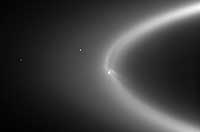|
COMETS EARTH JUPITER KUIPER BELT MARS MERCURY METEORITES NEPTUNE OORT CLOUD PLUTO SATURN SOLAR SYSTEM SPACE SUN URANUS VENUS ORDER PRINTS
PHOTO CATEGORIES SCIENCEVIEWS AMERICAN INDIAN AMPHIBIANS BIRDS BUGS FINE ART FOSSILS THE ISLANDS HISTORICAL PHOTOS MAMMALS OTHER PARKS PLANTS RELIGIOUS REPTILES SCIENCEVIEWS PRINTS
|
Related Documents
Download Options
Wispy fingers of bright, icy material reach tens of thousands of kilometers outward from Saturn's moon Enceladus into the E ring, while the moon's active south polar jets continue to fire away. This astonishing, never-before-seen structure is made visible with the sun almost directly behind the Saturn system from Cassini's vantage point. The sun-Enceladus-spacecraft angle here is 175 degrees, a viewing geometry in which structures made of tiny particles brighten substantially. These features are very likely the result of particles injected into Saturn orbit by the Enceladus geysers: Those injected in the direction of the moon's orbital motion end up on larger, slower orbits and trail Enceladus in its orbit, and those injected into the opposite direction end up smaller, faster orbits and lead Enceladus. (Orbital motion is counter-clockwise.) In addition, the configuration of wisps may hint at an interaction between Saturn's magnetosphere and the torrent of particles issuing from Enceladus. In addition to the wisps, another unexpected detail is the dark gore in the center of the ring, following the moon in its orbit, likely brought about by the sweeping action of Enceladus as it orbits in the center of the E ring. The view looks down onto Enceladus (505 kilometers, or 314 miles across) from about 15 degrees above the ringplane. Tethys (1,071 kilometers, or 665 miles across) is visible to the left of Enceladus. The image was taken in visible light with the Cassini spacecraft wide-angle camera on Sept. 15, 2006, at a distance of approximately 2.1 million kilometers (1.3 million miles) from Enceladus. Image scale is 128 kilometers (80 miles) per pixel. |
